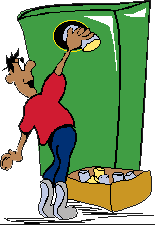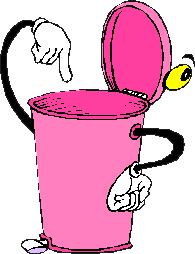| |
Recycling Facts & Trivia
Glass
- Glass never wears out -- it can be recycled forever.
- We save over a ton of resources for every ton of glass recycled -- 1,330 pounds
of sand, 433 pounds of soda ash, 433 pounds of limestone, and 151 pounds of
feldspar.
- Most bottles and jars contain at least 25% recycled glass.
- Recycling just 1 glass bottle saves enough energy to light a 100-watt light bulb
for 4 hours, power a computer for 30 minutes, or a television for 20 minutes.
- In 2011, 34.2% of all glass containers were recycled, which is the equivalent to
taking 210,000 cars off the road each year.
- It takes approximately 1 million years for a glass bottle to break down at the
landfill.
- Glass recycling is often separated into colors because glass keeps its color
after recycling.
- For every ton of recycled glass turned into new products, 315 kilograms of extra
carbon dioxide that would have been released during the creation of new glass
are saved.
Metals
- Steel producers in the United States use more than 70% recycled steel.
- 100 lbs. Of recycled steel replace almost 150 lbs. Of steel ore. When steel cans
were introduced in 1935, they weighed 172 lbs. per thousand; today, they weigh
70 lbs. per thousand.
- Americans throw away enough steel every year to build all the new cars made in
America.
- Tin cans are actually 99% steel, with a thin layer of tin added to prevent
rusting.
- For every pound of steel that is recycled, enough energy is saved to light a
60-watt bulb for more than a day.
- The aluminum cans recycled in 2010, stacked one on top of the other, would be
1,454 times taller than the Empire State Building.
- Used aluminum cans are recycled and back on the shelf as new cans in as few as
60 days.
- Tossing away an aluminum can wastes as much energy as pouring out half of that
can's volume of gasoline.
Paper
- Paper accounts for more than a half of all recyclables collected in the US, by
weight. Nearly forty-six million tons of paper and paperboard were recovered in
2011-a recycling rate of almost 66 percent.
- Seventy-five percent of a tree harvested for paper does not wind up as paper
product.
- One ton of paper requires the use of 98 tons of various resources.
- Paper made from recycled paper instead of virgin fiber requires 70% less energy.
- Using recycled scrap paper instead of virgin material saves 7,000 gallons of
water per ton of paper produced.
Plastic
- Americans use 4 million plastic bottles every hour! - Yet only 1 bottle out of 4
is recycled.
- In 1977, polyethylene terephthalate soda bottles were introduced to the market.
- Five 2-liter recycled beverage bottles make enough fiberbill to make a ski
jacket.
- Every pound of recycled PET used in place of virgin material reduces energy use
in plastic production by 84% and greenhouse gas emissions by 71%.
Miscellaneous
- Recycling conserves natural resources such as trees, water and minerals -
preserving the environment for future generations.
- For every $1,000 of fast food sales, 200 pounds of trash is created.
- In 2009, Americans recycled 82 million tons of materials. The resulting CO2
emission reduction is equivalent to taking 33 million passenger vehicles off the
road.
- Every year we dispose of 24 million tons of leaves and grass clippings, which
could be composted to conserve landfill space.
- Single-use bags are a waste of trees (paper) or fossil fuels (plastic). They
contribute to water pollution during production and landfill overload at
disposal. Re-usable cloth or paper bags reduce these problems.
- Recycling is a continuous loop that works only if the collected materials are
turned into products, bought and used again. Buying products made from recycled
materials supports the markets for these products and keeps the cycle going.
- Around 200 B.C. the Chinese used old fishing nets to make the world's very first
piece of recycled paper.
- Curbside recycling originated in 1874 in Baltimore.
- Gary Dean Anderson designed the recycling symbol in 1970.
- The first municipal dump was established in 400 B.C. in ancient Athens.
Myths & Facts
Myth:We can recycle only 25 to 30% of our solid wastes.
Fact: 25% was considered a maximum level in 1985. In 2011, the recycling
rate for Washington State reached 50.7%; the first time the recycling rate
topped the 50% goal set by a 1989 Washington state law.
Myth: Landfills and incinerators are more cost-effective and
environmentally sound than recycling options.
Fact: Recycling programs, when designed properly, are cost-competitive
with landfills and incinerators, and provide net pollution prevention benefits.
Recycling materials not only avoids the pollution that would be generated
through landfilling and incinerating these, but also reduces the environmental
burden of virgin materials extraction and manufacturing processes.
Myth: Landfills are significant job generators for rural communities.
Fact: Recycling, where instituted, creates many more jobs for rural and
urban communities than landfill and incineration disposal options.
|
|

Recycle�don�t just toss everything in the trash. Lots of things (like cans,
bottles, paper, and cardboard) can be remade into either the same kind of thing
or new products. Making new items from recycled ones also takes less energy and
fewer resources than making products from brand new materials.
Just about anything in your home (or office or school, etc.) that cannot be
reused CAN be recycled into something else. You'd be amazed what can be done
with a recycled product! A recycled soda bottle, can be made into T-shirts,
combs, or hundreds of other plastic goods that can be used for many years. Even
your brand new computer case might be made from ordinary recycled plastics. And
paper products can take on different forms as well; an old phone book or
coloring book might become one of your school books or a notebook.
Your recycling mission is not impossible! In fact, it is very simple:
Don't throw away anything that can be recycled!
Here is a list of things you may be able to recycle
- Aluminum cans
- Cardboard
- Electronic equipment
- Glass (particularly bottles and jars)
- Magazines
- Metal
- Newspaper
- Paper
- Plastic Bags
- Plastic Bottles
- Steel Cans
- Writing/Copy Paper
- Yard Waste (leaves, grass)
Just ask your local recycling office (city, county, or state) about what can be
recycled.
Now isn't that easy? There is so much that YOU can do with very little effort.
And the best part is you will probably save yourself a lot of money while you
are at it!

|
|
|
